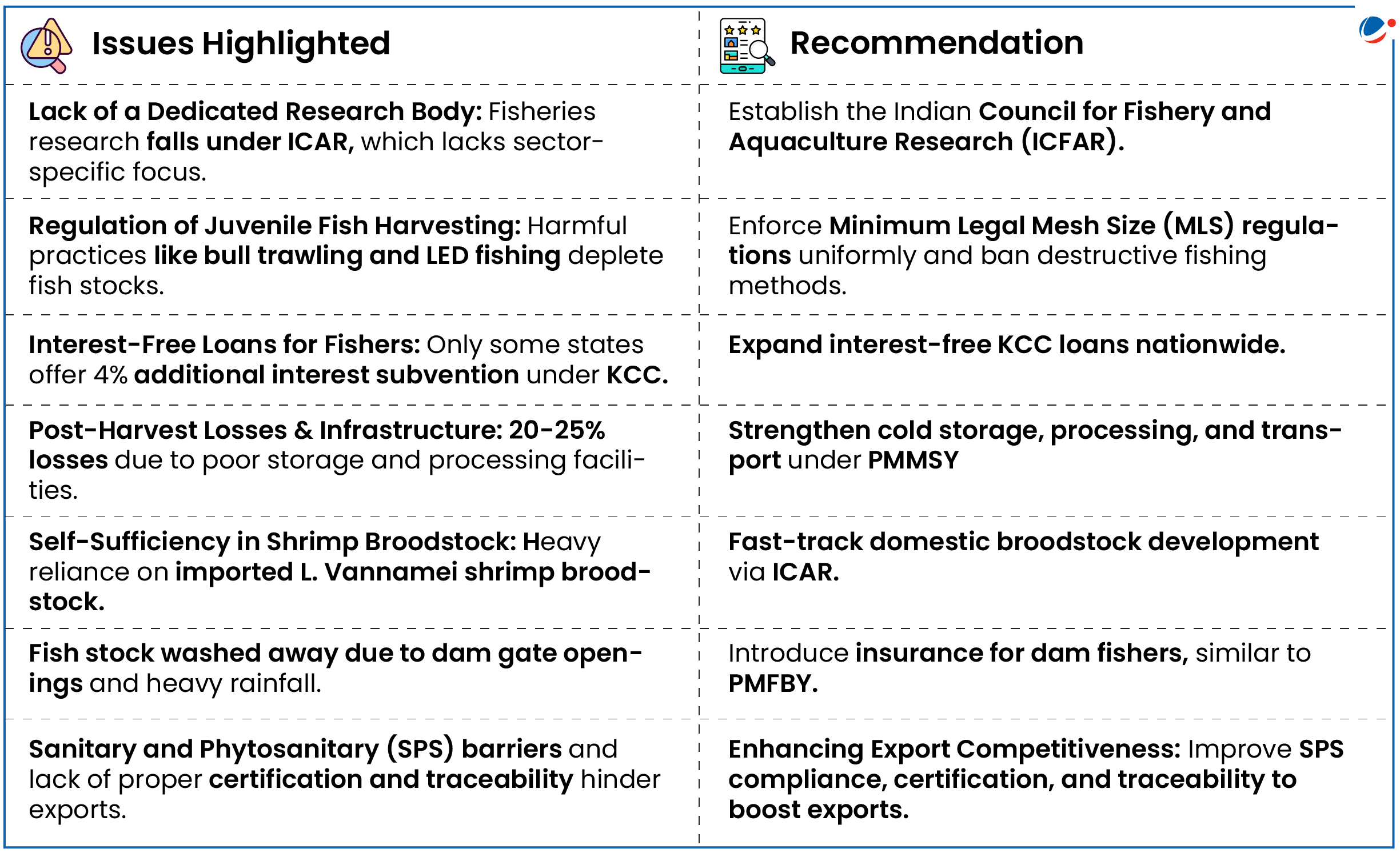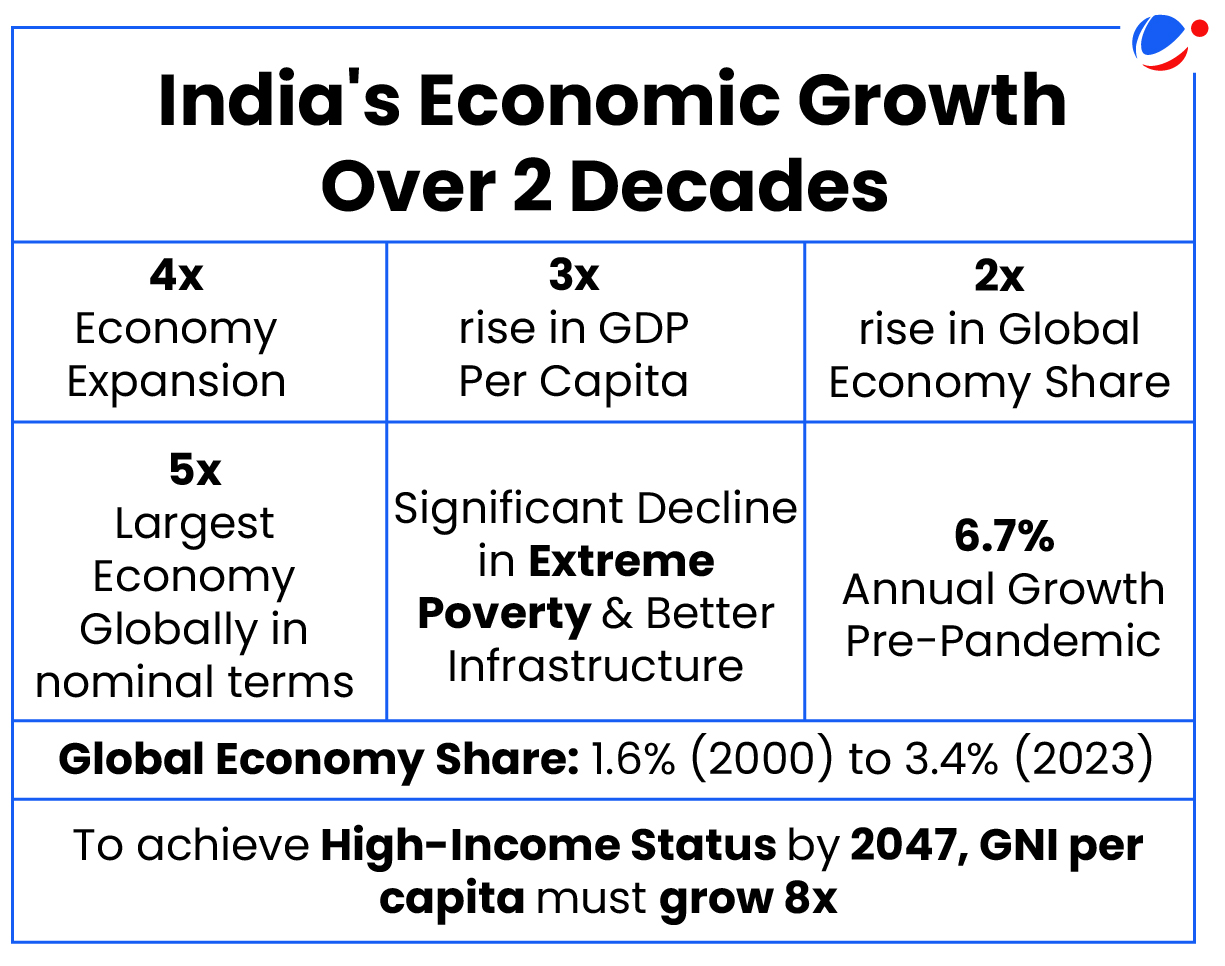Making CSR, IBC & ESG Effective
10th report on ‘Demands for Grants (2025-26)’ of Ministry of Corporate Affairs (MCA) highlights various issues and gives recommendations thereof for making Corporate Social Responsibility (CSR), Insolvency and Bankruptcy Code (IBC) & Environmental, Social and Governance (ESG) Regulations effective:
Areas | Issues | Recommendations |
Corporate Social Responsibility (CSR) |
|
|
Insolvency and Bankruptcy Code (IBC) |
|
|
Environmental, Social and Governance (ESG) Regulations |
|
|
- Tags :
- ESG
- IBC
- CSR
Parliamentary Standing Committee on Agriculture Submits Report on Fisheries Sector
The report evaluates the government's response to recommendations aimed at improving the fisheries sector, enhancing employment opportunities, and increasing revenue generation.
- India is 3rd largest fish-producing country, accounting for approximately 8% of global fish production.
- Over the years, the sector’s contribution to agricultural GVA has risen from around 4% to over 6.72%.
Key Highlights

- Tags :
- Fisheries
Scheme for Cooperative Sugar Mills
Recently, Union Government has notified a scheme for Cooperative Sugar Mills under modified Ethanol Interest Subvention Scheme.
About Scheme for Cooperative Sugar Mills
- Ministry: Ministry of Consumer Affairs, Department of Food & Public Distribution
- Aim: Conversion of existing sugarcane-based feedstock ethanol plants into multi-feedstock based plants to use grains like Maize and Damaged Food Grains (DFG).
- Under modified Ethanol Interest Subvention Scheme, Government is providing Interest subvention @ 6% per annum or 50% of rate of interest charged by banks/financial institutions, whichever is lower.
- Tags :
- sugar mills
Articles Sources
Tobacco
India’s tobacco exports have doubled over the last 4 years.
Tobacco
- India’s Status: Second largest producer (after China) as well as second largest exporter (after Brazil).
- Major Producing States: Gujarat (45% of total cultivated area, 30% production), Andhra Pradesh, Karnataka, UP and Bihar.
- Favourable Conditions:
- Temperature: Between 20° to 27°C is required.
- Rainfall: When grown as a rainfed crop then requires at least about 500 mm of well-distributed rainfall during the crop growing season. (Usually not grown in the area if rainfall exceeds 1200 mm).
- Soil: sandy or sandy loam soil. Cigarette-tobacco growing areas of Andhra Pradesh are an exception in that the crop is grown on heavy black soil.
- Tags :
- tobacco exports
‘Becoming A High-Income Economy In A Generation' Report Released By World Bank
The report recognizes that India needs to grow by 7.8% on average over the next 22 years to become High-Income Country (HIC) by 2047.
- India became a Low Middle-Income Country (LMIC) in 2007-08 and is currently on track to become an Upper Middle-Income Country (UMIC) by 2032.

Key Challenges In Becoming HIC By 2047
- Slow Structural Transformation: Agriculture still employs 45% of the workforce (2023-24) while traditional market services and construction (low productivity) together constitute nearly 30%.
- In contrast, the share of manufacturing in total employment was around 11% and modern market services accounted for only 7%.
- Declining Private Investment: Private investment surged post-1990s reforms but it has fallen as a share of GDP, particularly since the global financial crisis in 2008.
- Underutilisation of Demographic Dividend: Over 2000-19, the working-age population increased by 37.4%, but employment increased by only 15.7%.
- During this period, the labor force participation rate fell from 58% to 49% remaining low by middle-income countries standards.
Key Strategies for Growth
- Boost Investment: Increase investment from 33.5% to 40% of GDP by 2035 through better financial regulations, easier MSME credit, and simplified FDI policies.
- Create Jobs: Encourage private investment in job-rich sectors like agro-processing, manufacturing, transport, and care economy.
- Balanced Regional Growth: Less developed states focus on basics (health, education, infrastructure), while developed states advance next-gen reforms.
- Tags :
- world bank
Bilateral Swap Agreement (BSA)
India and Japan have renewed the $75 billion bilateral currencies swap agreement.
About BSA:
- It is an agreement between two central banks to exchange a cash flow in one currency against a cash flow in another currency according to predetermined terms and conditions.
- Purpose of India - Japan BSA: It is a two-way currency swap mechanism, allowing both countries to exchange local currencies for US dollars when needed.
- Significance: Help manage exchange rate volatility and provide liquidity during financial crises
- Tags :
- India-Japan
- BSA
Digital Footprint-Based Lending For MSMES
Ministry of Finance launched a new credit assessment model using MSMEs' digital footprints to streamline credit appraisal and disbursement.
About New Credit Assessment Model
- It will leverage the digitally fetched and verifiable data available in the ecosystem and devise automated journeys for MSME loan appraisal.
- It aims to improve financial inclusion, reduce reliance on traditional credit scores, and support MSMEs with easier access to formal credit.
- It was announced in Union Budget 2024-25 that public sector banks (PSBs) will build their in-house capability to assess MSMEs for credit, instead of relying on external assessment.
- Tags :
- MSMEs
Articles Sources
Venture Capital (VC)
India’s Venture Capital (VC) funding surges 43% to $13.7 billion in 2024.
About VC
- It is a form of private equity and a type of financing for startup companies and small businesses with long-term growth potential.
- Venture capital usually takes the form of equity shares or a future claim on equity, such as convertible debt, which in return allows the venture capital firm to receive a share of ownership in the business.
- Venture capitalists provide backing through financing, technological expertise, or managerial experience
- Tags :
- Venture Capital
- Private Equity
Reinsurance
Valueattics Re has become the first private firm to receive IRDAI’s nod to commence reinsurance business in India.
- Currently, public sector General Insurance Corporation (GIC Re) is the only reinsurance company operating in India.
About Reinsurance
- Reinsurance is a risk management practice where insurance companies transfer a portion of their risk to another insurance company (reinsurer) to protect themselves from large financial losses.
- Regulator: Insurance Regulatory and Development Authority of India (IRDAI).
- Laws: Governed under the Insurance Act, 1938 and IRDAI (Re-Insurance) Regulations, 2018.
- Tags :
- IRDAI
- Reinsurance
- Isurance Act, 1948
Samarth
Centre for Development of Telematics launches ‘Samarth’ a cutting edge Incubation Program for telecommunications and IT sectors.
About Samarth
- Aim: Encourage the development of sustainable and scalable business models, offer access to cutting-edge resources, and help Startups Bridge the gap from ideation to commercialization.
- Implementation Partner: Software Technology Parks of India (STPI), premier S&T organization under Ministry of Electronics and Information Technology (MeitY).
- Tags :
- SAMARTH
- C-DOT
- Software Technology Parks of India
UpLink initiative
UpLink initiative under World Economic Forum’s (WEF) cut carbon emissions by 142,400 tonnes in 2023-2024.
About UpLink Initiative
- It is an initiative focused on impactful early-stage innovation.
- It was founded in 2020 by WEF in collaboration with Deloitte and Salesforce.
- It builds ecosystems that enable purpose-driven, early-stage entrepreneurs to scale their businesses for the markets that are essential to a net-zero, nature-positive and equitable future.
- Objectives: Accelerate impact of early-stage innovators, Enable Innovation Ecosystems and Influence perception.
- Tags :
- World Economic Forum
- UpLink Initiative
- Startup



